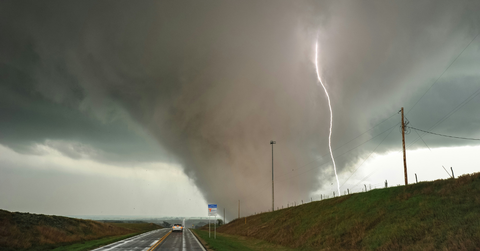Three People Killed By EF5 Tornado That Hit North Dakota, Breaking Records
The last EF5 tornado hit Oklahoma on May 20, 2013, killing 24 people in its wake.
Published Oct. 7 2025, 11:39 a.m. ET

On June 20, 2025, a tornado touched down near the town of Enderlin, North Dakota. The deadly twister left a sprawling path of debris in its wake, which spanned more than a mile wide in some areas. The tornado terrorized North Dakota for a terrifying 12 miles before dissipating and allowing folks to discover the true depth of destruction left behind.
Sadly, three people lost their lives that day. Months later, the National Weather Service (NWS) has released its findings about the storm.
According to them, the tornado was a record-breaker for a lot of reasons. Not only is it one of the first of its kind to his the U.S. in more than a decade, but the storm was named one of the strongest tornadoes to touchdown in the country since the NWS started using the Enhanced Fujita (EF) Scale to categorize them.
You can learn more about North Dakota's EF5 tornado, including what the experts say those in its path likely experienced, below.

What is an EF5 tornado?
To understand an EF5 tornado, first, you must understand the Enhanced Fujita Scale. According to the organization, the NWS adopted this tool on Feb. 1, 2007, to give tornadoes a clearer rating based on damage and wind speeds.
The NWS comes up with the EF Scale by using other tools — like a list of Damage Indictors (DIs) and something called Degrees of Damage (DoD) — to calculate the wind speeds, which determines the 0-5 rating.
It's worth noting that this scale is a complex one, since it uses data gathered after the fact to determine wind speeds, and often has to take a series of variables into consideration when assigning a value to damaged buildings, since some buildings may have been built to withstand stronger storms than others, especially with modern construction where there are strict codes in place.
What is an EF5 tornado's wind speed?
The EF Scale uses three-second wind gusts to determine the wind speeds of the tornado. And while some gusts are notably lower than others — for example, an EF0 tornado's wind speed clocks in between 65 and 85 miles per hour when they reach top speed — an EF5 tornado's winds can get considerably higher.
In fact, the wind rating needs to clock in at a minimum of 200 miles per hour to qualify as an EF5, and there is no cap on how high they can go.
When was the last EF5 tornado in the U.S.?
When you realize just how high winds can get during an EF5 tornado, it's easy to see how these weather systems can cause so much damage. Fortunately, there haven't been too many of them to hit our country. According to Wikipedia, there have only been 11 tornadoes to rate this high on the EF Scale, and 10 of them touched down in the U.S.
Before the North Dakota storm, the most recent one hit Oklahoma on May 20, 2013, killing 24 people in its wake.